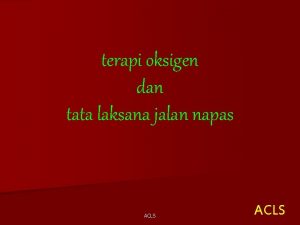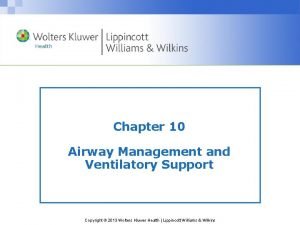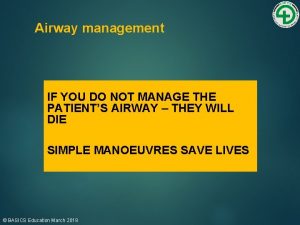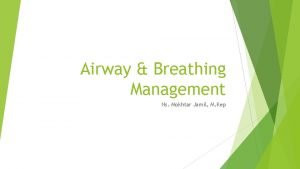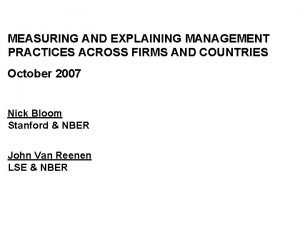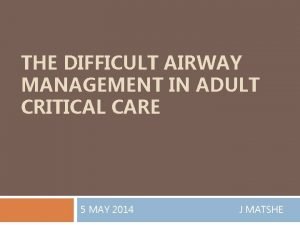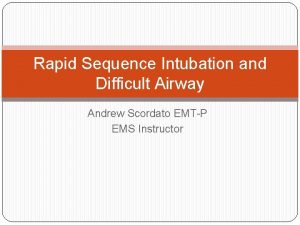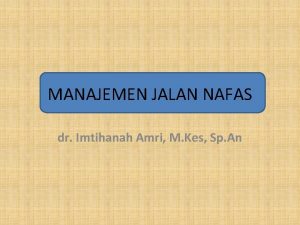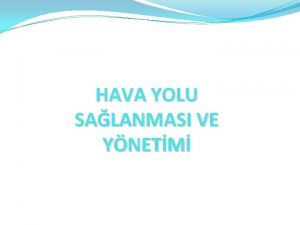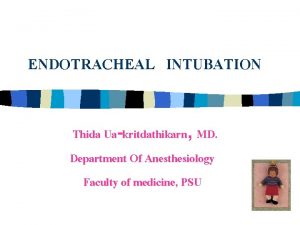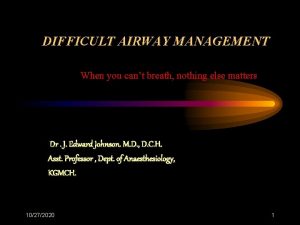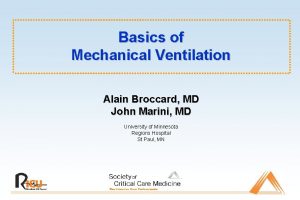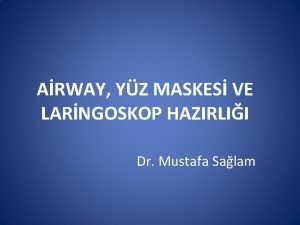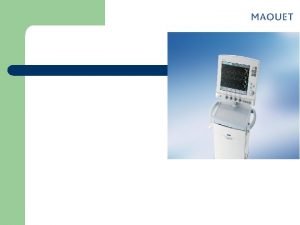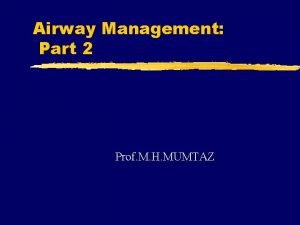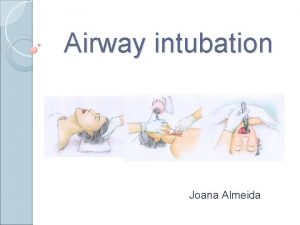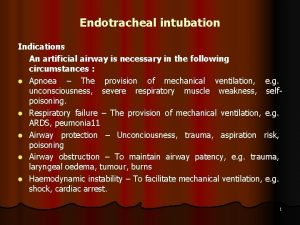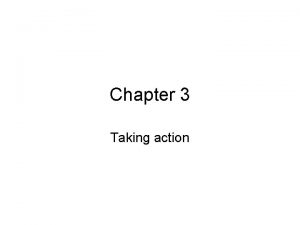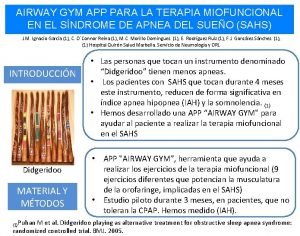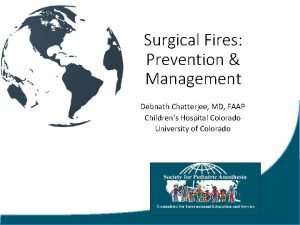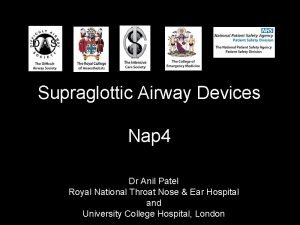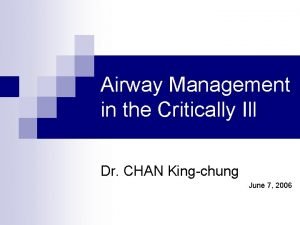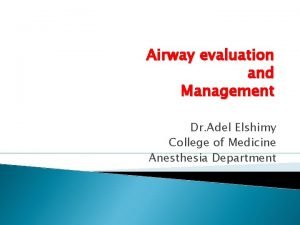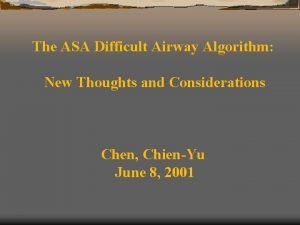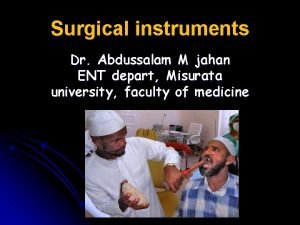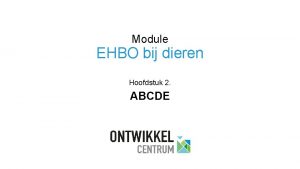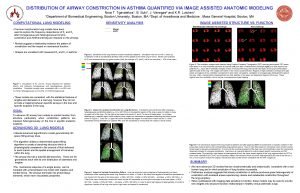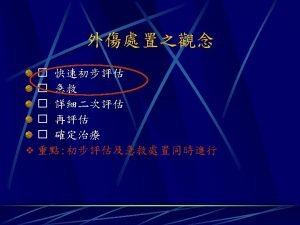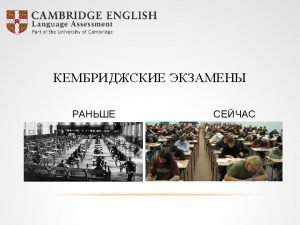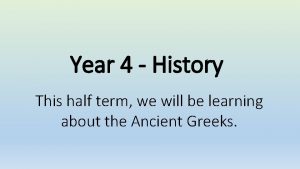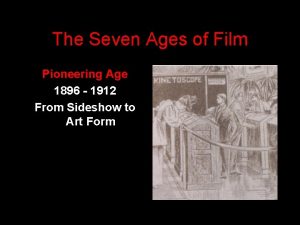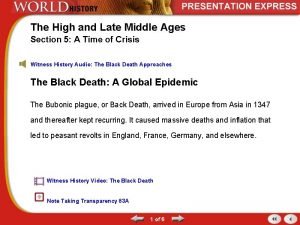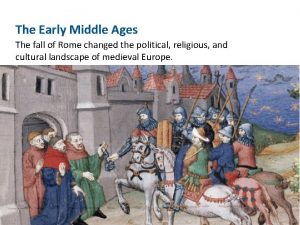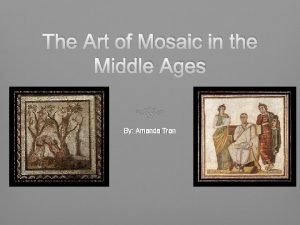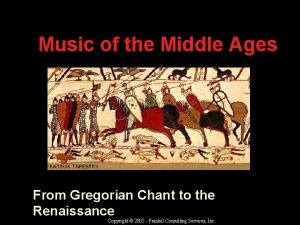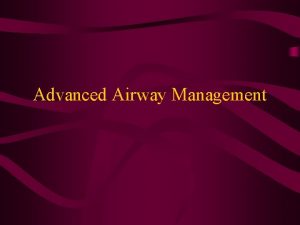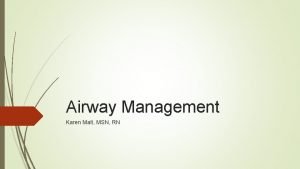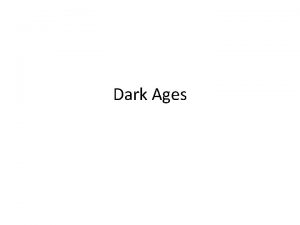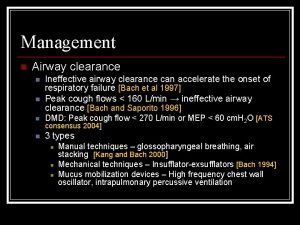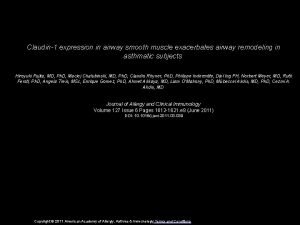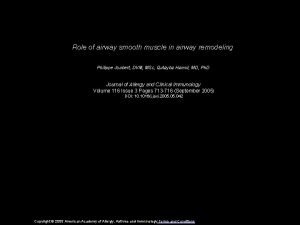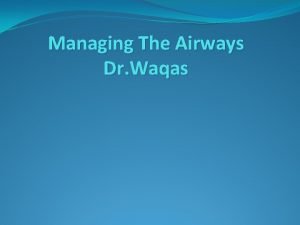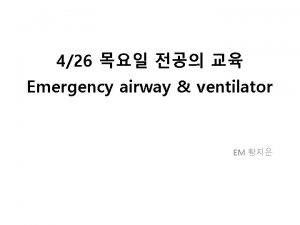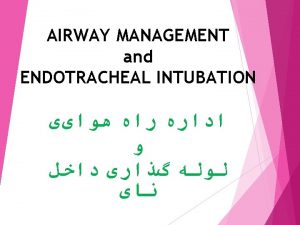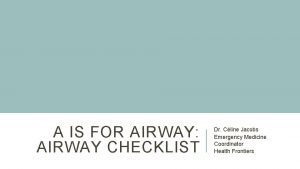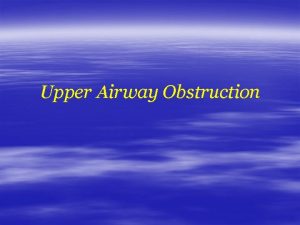Airway Management Across the Ages The Airway World







































































- Slides: 71

Airway Management Across the Ages. The Airway World from Biblical Times Until WWII D. John Doyle MD Ph. D Chief, Department of General Anesthesiology Cleveland Clinic Abu Dhabi

Disclosure: No Conflicts of Interest • No active industry grants • No paid advisory positions • Have been provided with equipment for studies and clinical evaluation by a number of manufacturers


Andranik (“Andy”) Ovassapian (1936 -2010)

Dr. Ovassapian’s Most Difficult Airway Case

www. samhq. com

Airway Management Across the Ages

Giving Due Credit Although several sources were studied to prepare this information, the following historical review by Dr John R. Davidson was used extensively and deserves special mention: J. R. Davidson, Intubation: What’s Old, What’s New. Anesthesiology Clinics of North America. June 1995, pp. 377 -390.

Some Landmarks in Clinical Airway Management Biblical Times Death from airway obstruction recognized (trauma [strangulation], leprosy, abscesses) 1700 s Metal and leather tubes inserted blindly into the trachea for treatment of drowning 1842 Crawford Long discovers ether anesthesia 1854 Garcia, a professor of singing, develops indirect laryngoscopy 1878 Chloroform administered through tracheal tube (Macewen) 1885 O’Dwyer popularizes intubation for diphtheria 1895 Kirstein develops direct laryngoscopy 1900 Kuhn develops a flexometallic tracheal tube World War I Many casualties requiring head and neck surgery adds impetus to widespread use of intubation 1920 Chevalier Jackson designs improved laryngoscope 1920 s Magill develops blind nasal intubation 1942 Griffiths introduces curare into clinical practice 1946 Mendelson describes aspiration pneumonitis 1950 s Popularization of the use of tracheal tubes for general anesthesia 1960 s Advent of electronic patient monitoring 1962 Sellick maneuver and rapid-sequence induction developed 1940 s-1970 s Continuing improvements in laryngoscope and tube designs; use of plastic 1970 s Development of implant-tested low-irritation, low-cuff pressure disposable tracheal tubes 1980 s Popularization of fiberoptic intubation. Introduction of pulse oximetry and capnography as noninvasive means of assessing oxygenation and ventilation. 1990 s Popularization of laryngeal mask airway, rigid fiberoptic laryngoscopes (Bullard, Wu, etc. , ) and ASA Practice Guidelines for Management of the Difficult Airway. 1995 Founding of the Society for Airway Management (www. samhq. com) 2000 s Introduction of video laryngoscopes (Glide. Scope, Mc. Grath etc. )

Airway Management in the Old Testament Elijah Reviving the Son of the Widow of Zarephath

Airway Management in the Old Testament Elijah performed mouth-to-mouth resuscitation on a child with heat stroke. This was the first example of assisted respiration. II Kings 4: 34 And he went up, and lay upon the child, and put his mouth upon his mouth, and his eyes upon his eyes, and his hands upon his hands: and he stretched himself upon the child; and the flesh of the child waxed warm. http: //www. emedicine. com/ent/byname/tracheostomy. htm

Religion and Airway Management Saint Blaise served as Bishop of Armenia in the fourth century. Little is known about his life, but legend tells us that he saved a small boy from choking on a fish bone. Because of this, his help is sought for those who are afflicted with illnesses of the throat. On February 3, the feast of Saint Blaise, many Catholic churches offer the blessing of throats.


Homer, describing the death of Hector, wrote that “his spear went right through the fleshy part of the neck, but did not sever his windpipe so he could still speak. ” Homer: The Iliad, Book 22, Paragraph 20. The Electronic Home Library, Ed 1, Ver 3. Garden Grove, CA, World Library

Aristotle, in his Parts of Animals, shows a sophisticated appreciation of the structure and function of the epiglottis, vocal cords, and trachea. Aristotle: Parts of Animals. Book 3, Chapter 3. The Electronic Home Library, Ed 1, Ver 3. Garden Grove, CA, World Library

Alexander the Great Alberti mentions that Alexander the Great is reputed to have opened the trachea of a soldier given up for dead with the point of his dagger. Alberti PW. Tracheostomy versus intubation. A 19 th century controversy. Ann Otol Rhinol Laryngol 93: 333 -337, 1984

Hippocrates Alberti also maintains that Hippocrates described and used an angled tube to relieve airway obstruction caused by quinsy. He also condemned tracheostomy, citing threat to carotid arteries. Alberti PW. Tracheostomy versus intubation. A 19 th century controversy. Ann Otol Rhinol Laryngol 93: 333 -337, 1984

Avicenna The Arabian physician Avicenna (AD 980 - 1037) described airway management in his treatise Liber Canonis. Brant quotes a Latin passage : “When necessary, a cannula of gold, silver or other suitable material is advanced down the “throat” to support inspiration. ” Brant L. The first reported oral intubation of the human trachea. Anesth Analg 66: 1198 -1199, 1987.

Andreas Vesalius and his anatomy text, De Humani Corporis Fabrica Libri Septem (Seven Books on the Fabric of the Human Body) 1543.

Ancient engraving illustrating a tracheostomy procedure. From Armamentarium chirurgicum bipartitum, 1666. Courtesy of the National Library of Medicine. (Image edited for clarity).

First Clear Reference to Orotracheal Intubation It was not until 1788 that an indisputable reference to orotracheal intubation in humans occurred. Charles Kite, in his “Essay on the Recovery of the Apparently Dead” writes “the crooked tube, bent like a male catheter…should be introduced into the glottis, through the mouth or one nostril. . . Brant L. The first reported oral intubation of the human trachea. Anesth Analg 66: 1198 -1199, 1987

Instruments for the recovery of the apparently dead. The elastic blow-pipe for the lungs, the elastic tube of blue leather for conveying fumes to the Intestines, the elastic tube of black leather for conveying medicines into the stomach, the Fumigator and a bladder and pipe. (Wellcome Images)

A Curved Metal Catheter of the Type Recommended by Charles Kite

Inadvertent Awake Intubation Parisian surgeon P J Desault (1738 - 1795 ) was responsible for demonstrating the ability of a conscious patient to tolerate an indwelling orotracheal tube. He did this inadvertently, thinking he had passed the tube into the esophagus for the purposes of providing nourishment. A flickering of a lighted candle at the end of the tube demonstrated the tube’s intratracheal position. Applebaum EL, Bruce DL. Tracheal Intubation. WB Saunders, 1976

Blind Intubation for Drowning In their 1796 description of “life-saving measures for drowning patients” Herholdt and Rafn advise passing a catheter blindly over the fingers placed posterior to the epiglottis. Applebaum EL, Bruce DL. Tracheal Intubation. WB Saunders, 1976

Diphtheria is an upper respiratory tract illness characterized by sore throat, low-grade fever, and an adherent membrane (a pseudomembrane) on the tonsil(s), pharynx, and/or nose. It is caused by Corynebacterium diphtheriae, an aerobic Grampositive bacterium.

Diphtheria Pseudomembrane at the back of the throat of a child. The membrane can grow and extend further down the throat, suffocating the child.

Diphtheria In the 1890 s, the German physician Emil von Behring developed an antitoxin that, although it did not kill the bacteria, neutralized the toxic poisons that the bacteria released into the body. For this discovery and his development of a serum therapy for diphtheria, he won the first Nobel Prize in Medicine (1901).

In February 1925, a deadly diphtheria epidemic was poised to sweep through Nome Alaska. The only serum that could stop the outbreak was in Anchorage, nearly 700 miles away. The only aircraft that could quickly deliver the medicine was taken out of winter storage, but its engine was frozen and would not start. After considering all of the alternatives, officials decided to move the medicine using a series of sled dogs. (Modified from Wikipedia)

Statue of Balto by Frederick Roth in Central Park (New York City, New York).

In late 1928 an outbreak of diphtheria occurred in Northern Alberta, Canada. On January 2, 1929, “Wop” May and his friend, Vic Horner, headed from Edmonton in the Avro “Avian” with the necessary diphtheria antitoxin.

Their flight path took them first to Mc. Lennan, where they spent the night, and then on to Peace River for refueling. They headed further north to Fort Vermilion, despite dangerously frigid weather and engine problems. The two pilots arrived safely with the antitoxin on January 3 and returned to Edmonton, January 6, to a cheering crowd of 10, 000.

Specifications for 1927 Avro Avian Maximum speed: 102 mph Cruise speed: 87 mph Initial climb: 650 ft/min Service ceiling: 18, 000 ft. Gas capacity: 35 gal. Max. range: 400 miles Wingspan: 28’ Length: 24’ 3” Height: 8’ 6” Tare weight: 1130 Max. weight: 2002 lbs.

Diphtheria One of the first early effective treatments was discovered in the 1880 s by U. S. physician Joseph O'Dwyer (1841 -1898). O'Dwyer developed tubes that could be inserted into the throat to prevent victims from suffocating from the membrane sheath that grew and obstructed the airways.

O’Dwyer Tubes and Insertion Instrument


Intubation Instruments (1. Gag 2. Introducer and Tube 3. Gauge 4. Extractor)

Figure from Intubation of the Larynx, showing the proper position of patient for a successful intubation. From Rutkow IM. Frank Waxham and Charles Truax's Intubation of the larynx. Archives of Surgery. 137(7): 870, 2002


On Oct. 16, 1846, William T. G. Morton, a Boston dentist, demonstrated the use of ether during surgery. The Ether Dome was designated a National Historic Site in 1965.


Early Anesthesia No definitive airway control Mask anesthesia, inhalers, drop mask techniques were all equally capable of producing an unconscious patient but offered no airway protection or control against apnea or emesis.

Ether Mask circa 1860

Full scale replica of the original inhaler used at the Ether Dome of Massachusetts General Hospital by William TG Morton (the world's first public demonstration of ether anesthesia for surgery).

Joseph Clover (1825 – 1882)

Joseph T Clover administering chloroform. Credit: Wellcome Library, London.

Joseph Clover 1825 – 1882 • Developed the first apparatus to provide chloroform in controlled concentrations. • Described jaw-thrust technique for opening airway. • Performed surgical airway with metal canula (first cricothyrotomy by an anesthesia provider).

Intubation for Anesthesia Trendelenburg In 1871 the famous German surgeon Trendelenburg adapted to human use a method of delivering chloroform via a tracheostomy tube, allowing him to pack off the pharynx and to prevent the aspiration of blood during oral and nasal procedures

Intubation for Anesthesia Macewen In 1878 William Macewen, a Glasgow surgeon was the first to administer endotracheal anesthesia. His first case involved resection of a massive oral tumor following awake intubation WITHOUT local anesthesia. (Cocaine did not enter clinical practice until 1884). James CDT: Sir William Macewen and anaesthesia. Anaesthesia, 29: 743 -753, 1974

Intubation for Anesthesia Macewen • Macewen’s second and third cases involved intubation for laryngeal edema following aspiration of pieces of hot potato. • In his second oral tumor case the patient could not tolerate the ETT after placement and begged to get chloroform prior to another attempt. Macewen acceded to the patients request, but the patient died on induction from an obstructed airway.

Intubation for Anesthesia Macewen Sample of a Macewen tube. Sir William Macewen used both gum elastic and flexometallic tubes. (Wellcome Institute Library, London, UK)

Intubation for Anesthesia Kuhn In Germany, influenced by the works of Macewen and O’Dwyer, in 1902 Franz Kuhn invented an ETT that was flexible, easy to insert and resisted kinking. A fitted stylette made the tube rigid for insertion. An ear piece attachment even allowed for the auscultation of breath sounds!

Intubation for Anesthesia Kuhn

Kuhn tracheal intubation set (preformed metal stylet with the flexible metal tracheal tube detached). Reproduced by courtesy of the Collection of the Instrument Maker Carl Reiner (Vienna, Austria).

Insufflation In the years leading up to WW I considerable interest in anesthesia by ether insufflation had developed

Magill • In the early 1920 s Magill reintroduced the concept of a large caliber tube allowing bidirectional gas flow (instead of merely using a narrow-bore insufflation catheter) • Invented Magill forceps and blind nasal intubation

A Magill Intratracheal Catheter Showing Both Insufflation and Egress Ports

Advent of Laryngoscopy

Advent of Laryngoscopy Manuel Garcia, Professor of Singing at the Paris Conservatory, used a system of mirrors to visualize his own vocal cords during phonation. 1854.

Indirect Laryngoscopy

Labordette’s Bivalved Laryngeal Speculum With Mirror (typical early indirect laryngoscopes)

Direct Laryngoscopy

Kirstein’s “Autoscope” Showing Two Blades 1897

Courtesy Google Books

Courtesy Google Books 1897

Instrument for Passing a Ligature Through the Epiglottis to Lift it

“ One of the greatest, if not the greatest laryngologists of all time. ” Chevalier-Jackson Laryngoscope

Suspension Laryngoscopy

View Obtained by Suspension Laryngoscopy


 Airway grade view
Airway grade view Dark ages vs middle ages
Dark ages vs middle ages Dark ages vs middle ages
Dark ages vs middle ages Indikasi nasopharyngeal airway
Indikasi nasopharyngeal airway Tracheostomy stoma
Tracheostomy stoma Opa and npa
Opa and npa Npa measurement
Npa measurement Abcde airway
Abcde airway Sandwich manuver adalah
Sandwich manuver adalah Stepwise approach to airway management
Stepwise approach to airway management Management practices across firms and countries
Management practices across firms and countries 332 rule intubation
332 rule intubation Upper respiratory tract labeled
Upper respiratory tract labeled Gas exchange
Gas exchange Respiratory airway secretary
Respiratory airway secretary Soap me airway
Soap me airway Cormack lehane
Cormack lehane Skor mallampati
Skor mallampati Pip and peep
Pip and peep Chin lift jaw thrust
Chin lift jaw thrust Mean airway pressure
Mean airway pressure Endotrakeal tüp numaraları
Endotrakeal tüp numaraları Vareculla
Vareculla Retroglottic airway
Retroglottic airway Lemon law airway assessment
Lemon law airway assessment Mean airway pressure formula
Mean airway pressure formula Ahi cpap
Ahi cpap Mild foreign-body airway obstruction
Mild foreign-body airway obstruction Airway numaraları
Airway numaraları Asa airway classification
Asa airway classification Aprv waveform
Aprv waveform What is this picture from
What is this picture from Ztechnique
Ztechnique Valeculla
Valeculla Airway anatomy intubation
Airway anatomy intubation Disturbed thought process nanda
Disturbed thought process nanda Indications for artificial airway
Indications for artificial airway The emergency action steps are:
The emergency action steps are: Airway gym
Airway gym Airway breathing c
Airway breathing c Difficult airway trolley
Difficult airway trolley Norwich terrier upper airway syndrome
Norwich terrier upper airway syndrome Moans airway
Moans airway Asa airway fire algorithm
Asa airway fire algorithm Generations of supraglottic airway devices
Generations of supraglottic airway devices Thyromental distance
Thyromental distance Nasopharyngeal airway
Nasopharyngeal airway Thin
Thin Asa airway
Asa airway Mouth gag airway
Mouth gag airway Open a casualty's airway
Open a casualty's airway Abcde environment
Abcde environment Mellampati
Mellampati Classroom.cloud
Classroom.cloud Constricted airway
Constricted airway Definitive airways
Definitive airways Starters, movers, flyers ket pet
Starters, movers, flyers ket pet Greek dark ages timeline
Greek dark ages timeline European middle ages map
European middle ages map Dark ages vs renaissance
Dark ages vs renaissance Seven ages of cinema
Seven ages of cinema Germanic kingdom
Germanic kingdom Greeks floral design
Greeks floral design The high and late middle ages section 5 quiz
The high and late middle ages section 5 quiz Early middle ages
Early middle ages Mosaic art in medieval period
Mosaic art in medieval period 5 major ice ages
5 major ice ages Socialization through the life course
Socialization through the life course Late middle ages timeline
Late middle ages timeline Gregorian chant composers
Gregorian chant composers Renaissance vs middle ages
Renaissance vs middle ages Feudalism def
Feudalism def



